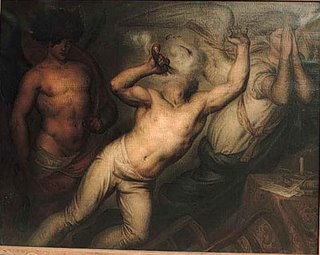In the Catholic translation of the Bible, the word "temptation" is used in various senses, the principal of which are the following:
. The act of testing or trying (Deuteronomy 4:34; Tobit 2:12; Luke 22:28; etc.);
. Enticement to evil (Matthew 26:41; 1 Corinthians 10:13; etc.);
. The state of being tempted (Matthew 6:13; Luke 4:13; etc.);
. That which tempts or entices to evil (James 1:12; 2 Peter 2:9; etc.);
. The name of a place (Exodus 17:7; Deuteronomy 6:16; etc.)
Taken in an unfavourable sense as denoting enticement to evil, temptation cannot be referred directly to God or to Christ, so that when we read in Gen., XXII, 1, for instance, "God tempted Abraham", and in John, VI, 6, "Hoc autem dicebat tentans eum", literally: "This He said tempting him", the expressions must be taken in the sense of testing, trying. According to St. James (I, 12 sqq.), the natural source of man's temptations is concupiscence, or that proneness to evil which is the result of the fall of Adam, and which remains in human nature after baptismal regeneration, and even though the soul is in the state of sanctifying grace (cf. Romans 8:1). Concupiscence becomes sinful only when freely yielded to; when resisted with God's help it is an occasion of merit. Together with inward concupiscence, and outward creatures, which may be the occasion of sin (I John II, 15 sqq.), the chief cause of temptation is Satan, "the tempter" (Matthew 4:3), bent on man's eternal ruin (Ephesians 6:10 sqq.). In the Lord's Prayer, the clause "Lead us not into temptation" is an humble and trusting petition for God's help to enable us to overcome temptation when His Fatherly Providence allows us to experience the allurements of evil. Prayer and watchfulness are the chief weapons against temptation (Mark 14:38; etc.). God does not allow man to be tempted beyond his strength (1 Corinthians 10:13).
Like Adam, Christ (the second Adam) endured temptation only from without, inasmuch as His human nature was free from all concupiscence; but unlike Adam, He withstood the assaults of the Tempter on all points, thereby affording His mystical members a perfect model of resistance to their spiritual enemy, and a permanent source of victorious help (Hebrews 4:15-16). In our first three Gospels (Matthew 4:1-11; Mark 1:12-13; Luke 4:1-13), the narrative of Christ's temptation is placed in immediate connexion with His baptism on the one hand, and with the beginning of His public ministry on the other. The reason of this is clear.
The Synoptists naturally regard the baptism of Christ as the external designation of Jesus from above for His Messianic work to be pursued under the guidance of the Holy Spirit bestowed upon Him on this occasion; and they no less naturally regard Christ's sojourn in the desert where He was tempted, as His own immediate preparation for that great work under the guidance of the same Holy Spirit.
As our first three Gospels agree concerning the time to which they assign the temptation of Christ, so they are at one in ascribing the same general place to its occurrence, viz. "the desert", whereby they no doubt mean the Wilderness of Judea, where Jesus would indeed be, as St. Mark says: "with beasts". From St. Mark (i, 13) -- with whom compare St. Luke iv, 2 -- we learn that Jesus Christ was tempted during the forty days which He spent in the desert (cf. St. Augustine, "Harmony of the Evangelists", II, xvi), so that the three onsets given in detail by St. Matthew and St. Luke are apparently the three final assaults of Satan against Christ.
The first of these assaults is directly connected in both St. Matthew and St. Luke with the prolonged fast of Jesus in the wilderness. The Tempter suggested to Jesus that He should use His miraculous power to relieve His hunger, by changing into bread the loaf-like flints of the desert. The two other assaults are given in a different order, St. Matthew adhering probably to the order of time, and St. Luke to that of place. The spot pointed out by tradition as the summit from which Satan offered to Jesus dominion over all earthly kingdoms is the "Quarantania", a limestone peak on the road from Jerusalem to Jericho.
As regards the Temple's pinnacle from which the Tempter bade Jesus cast Himself down, it was not the top of the House of Yahweh, but probably the roof of Solomon's portico from which, at a later date, St. James was actually hurled to the pavement below (Eusebius, "Hist. eccl.", IV, xiii).
According to St. Luke (IV, 13), after having subjected Christ to all kinds of temptations -- the Messianic import of which is undoubted -- Satan withdrew, awaiting a favourable opportunity like that which followed Christ's prolonged fast in the desert. The later conflict thus alluded to is no other than that of Christ's Passion (cf. Luke 22:53; John 14:30). The ministry of angels to Jesus, in connection with His temptation, is mentioned in Mark, I, 13.
Satan's exact manner of appearance to Jesus is not stated by the Evangelists. Despite the difficulties urged, chiefly by non-Catholic scholars, against the historical character of the three temptations of Jesus, as recorded by St. Matthew and St. Luke, it is plain that these sacred writers intended to describe an actual and visible approach of Satan, to chronicle an actual shifting of places, etc., and that the traditional view, which maintains the objective nature of Christ's temptations, is the only one meeting all the requirements of the Gospel narrative.
















